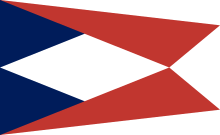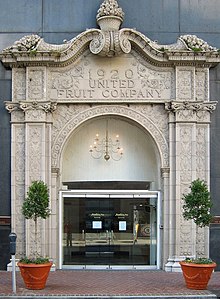Our website is made possible by displaying online advertisements to our visitors.
Please consider supporting us by disabling your ad blocker.
United Fruit Company
 The maritime flag of the United Fruit Company[1] | |
| Industry | Agriculture |
|---|---|
| Predecessors | |
| Founded | March 30, 1899 |
| Defunct | June 30, 1970 (as United Fruit Company) August 1984 (as United Brands) |
| Fate | Merged with AMK to become United Brands Company |
| Successor | Chiquita Brands International |
Area served | United States, Europe, Canada |
| Products | Primarily bananas Also pineapples, grapefruits, and other fruits |
Production output | 49,845,000 bunches of bananas (stalks)[2]: 60 |
| $22.8 million (1927[2]) | |
Number of employees | 67,000 (1930[3]) |

The United Fruit Company (later the United Brands Company) was an American multinational corporation that traded in tropical fruit (primarily bananas) grown on Latin American plantations and sold in the United States and Europe. The company was formed in 1899 from the merger of the Boston Fruit Company with Minor C. Keith's banana-trading enterprises. It flourished in the early and mid-20th century, and it came to control vast territories and transportation networks in Central America, the Caribbean coast of Colombia, and the West Indies. Although it competed with the Standard Fruit Company (later Dole Food Company) for dominance in the international banana trade, it maintained a virtual monopoly in certain regions, some of which came to be called banana republics – such as Costa Rica, Honduras, and Guatemala.[4]
United Fruit had a deep and long-lasting effect on the economic and political development of several Latin American countries. Critics often accused it of exploitative neocolonialism, and they described it as the archetypal example of the influence of a multinational corporation on the internal politics of the so-called banana republics. After a period of financial decline, United Fruit merged with Eli M. Black's AMK in 1970 to become the United Brands Company. In 1984, Carl Lindner, Jr. transformed United Brands into the present-day Chiquita Brands International.
- ^ "House flag, United Fruit Corporation Inc | Royal Museums Greenwich". www.rmg.co.uk. Retrieved 2023-02-02.
- ^ a b Irons, Oliver (1929). The history of the American fruit industry in the Caribbean (PDF). University of the Pacific. p. 91. Archived from the original (PDF) on 2025-01-04. Retrieved 2025-01-04.
- ^ "Banana Cowboys: The United Fruit Company and the Culture of Corporate Colonialism". Retrieved 2025-01-03.
- ^ Opie, Frederick Douglass (July 2009). Black Labor Migration in Caribbean Guatemala, 1882–1923. Florida Work in the Americas. University of Florida Press.
Previous Page Next Page


